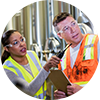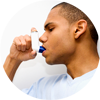Concentra Telemed® Now Available in Nevada – What This Means for You and Your Employees
August 2022 Nevada Telemedicine Webinar Transcript
Concentra Telemed is Now Available in Nevada
8/30/22
This webinar provides an overview of Nevada’s current regulations regarding telemedicine for workers’ compensation and includes the following details:
- How telemedicine can benefit your employees and organization
- Which types of injuries are appropriate for Concentra Telemed®
- How an employer can get started with Concentra Telemed
Welcome and Introduction of Speaker
0:00 – 0:29
Hello. Thank you for joining Concentra’s Telemed webinar, “Concentra Telemed is Now Available in Nevada.” Our keynote speakers today will be Ann Schnure, our vice president of telemedicine, and Dr. Lisa Figueroa, vice president of medical operations, national medical director of health information technology, and national medical director of telemedicine. I will be serving as moderator. My name is Megan Hart, director of telemedicine sales. Ann, you may now begin.
The Benefits of Using Telemedicine
0:30 – 2:59
Well, the first thing I’m going to talk about is, “What are the benefits of using telemedicine in workers’ comp?” So, the first thing is absolutely convenience – 24/7, 365/access to care. When we say 365, that means the sun never sets on our telemedicine product. We are open on all holidays and all weekends, regardless. We always have around-the-clock access to care. We have rapid connectivity. It’s easy to use and easy to get on with user-friendly technology, with very few steps for what a patient has to do to get connected. Concentra works with all existing nurse triage companies. We have worked out workflows with all of them on how to easily get a patient referred to telemedicine and get them connected. We have choices. We can either do on-demand where the patient comes onto the platform, or we can pre-schedule a visit where they get a link to click on at the time of their visit. We also see patients through the entire course of care. Lots of our cases start in telemedicine and end in telemedicine, so the entirety of care was provided via telemedicine. There is no need to leave the workplace or job site, home, or wherever for your visit. There are no transportation issues, and there is less time away from work, your family, etc.
We have improved outcomes. All of our clinicians that do telemedicine for Concentra are employees of Concentra, and they are trained specifically in occupational medicine. We have fewer missed appointments because it is easy to have your appointment or recheck because you don’t have to leave wherever you are to have that appointment. There is easier, quicker access to care. We can prevent worsening symptoms and repeat injuries with this. And then there is always the enhanced employee-patience experience and improved morale.
Under cost reductions, shortened case durations get people fully released. Emergency department avoidance refers to the fact that we are always open 365 days per year, and people don’t have to visit an emergency department as their only choice. And then, most importantly, we are compliant with all state, local, and governing body regulations. And before we go to the next slide, I want to point out that what that means is that telemedicine first has to make sure that you can do it with the state regulations even before you get to workers’ comp, and then you have to look at the licensing in the state. For every medical board in the United States, there are rules for how you can get licensed as a telemedicine provider in their state. Next slide.
Previous Challenges for Workers’ Comp Telemedicine in Nevada
3:00 – 4:06
So, let’s talk about the journey and where we’ve been with telemedicine in Nevada. So, if everyone that is on is familiar with Nevada, they should know that the C-4 form has been the challenge and the impediment to doing telemedicine for the first injury visit in workers’ compensation. That is because the C-4 originally required two wet signatures – the wet signature of the patient as well as the wet signature of the provider. If the forms were filled out incorrectly, you could get fined up to $1,000 per incorrect form. I want to point out that Nevada was never against telemedicine. They just had to figure out how to get it solved with the regulations of how workers’ compensation is administered in Nevada to make sure that a quality visit can happen and also can be in compliance. Another hurdle was the restrictions on the types of clinicians that could conduct telemedicine visits. Go to the next slide.
Changes to Nevada Telemedicine Rules and Regulations
4:07 – 6:01
So, I want to just talk quickly about where that journey has been. Back in 2018, Concentra looked at doing telemedicine in Nevada and said, you know – we tried to figure out with the state of Nevada division of workers’ compensation what needed to be done – and at that point, they had agreed that a wet signature was no longer required for a clinician and that an electronic signature would be okay. But we still had to solve for the wet signature of the patient. The wet signature of the patient was difficult because we could send them the form, they would have to sign it, and then we would be legally responsible to get it back. We walked through scenarios there and realized that it really wasn’t a good employer, patient, or provider experience to try to get wet signatures. So, instead, we put the efforts in with what needed to happen legislatively in the state of Nevada to allow for an electronic signature from the patient. And then, as we all know, COVID happened – which caused governments in all states of the United States to be interested acutely in telemedicine and to look at what the impediments were. I have to say that was probably very timely in pushing that along. So, finally in 2021, SB289 in Nevada allowed for an electronic signature on the C-4, which was great. Then in October 2021, they gave a new definition of telemedicine, and I know in Nevada telemedicine is actually referred to as telehealth. So, those two things combined paved the way for Concentra to say, “We believe we can now offer a product for new patient injuries in the state of Nevada that will keep everyone in compliance on the C4 and also give another great access-to-care solution for injured workers. Next slide.
Concentra Telemed is Available Almost Everywhere
6:02 – 7:16
So, on our journey, I want to point out that we are not just in Nevada. We started out with telemedicine in 2017. We started out in California and said, “Hey, we are going to learn about telemedicine and what makes a good product and go state by state.” And we grew, adding states – sometimes one at a time and sometimes several at a time – going through all the state regulations with both the medical boards and the work comp, talking to payors and employers, etc. to make sure that we were in compliance and then providing quality care in that state that met all of the requirements to have that done. As you can see now, these are all the jurisdictions we are in – including Nevada – and we are very proud of the fact that we have seen in excess of 200,000 visits in telemedicine and feel like we really are the best in class in delivering a quality product in telemedicine as we move across the landscape and just the nuances between state to state for what is required to make a quality visit happen in occupational medicine. And with that, turn to the next slide. I am going to turn it over to Dr. Lisa Figueroa.
An Overview of Concentra Telemed
7:17 – 9:14
Thank you, Ann. As many of you may (or may not) know, Concentra has 42+ years of experience in occupational health. And with that experience comes expertise in caring for the injured workers. We focus on outcomes. We have the knowledge and understanding of OSHA recordability, the importance of returning patients back to work as quickly as possible, and the state regulations – and we work extremely well within the workers’ comp ecosystem. We have a clinical model at Concentra that has proven, great outcomes, and we follow that clinical model in our centers as well as in telemedicine. Our telemedicine experience, as Ann has stated, started in 2017 – so we have five-plus years of experience. We have highly qualified, vetted telemedicine clinicians who are Concentra employees. We do not have 1099 clinicians on Concentra Telemed. We manage the entire case in telemedicine for the vast majority of the injuries. So, when a patient presents at Concentra Telemed for injury care, we usually see them through the duration of the case. Now, if that case is not progressing as it should or if symptoms worsen and the patient is not doing well, then by all means our clinicians will refer that patient for in-person evaluation and care. We utilize a secure, stable video platform with 24/7 video support, and we have our clinicians and our Concentra Telemed colleagues documenting in our EHR. So, the information that is available through Concentra Telemed is also available at our Concentra centers. That allows for ease and continuity of care for these patients.
Patient Engagement
9:15 – 10:29
Patient engagement: our injured employees need easy access that is convenient for them to get quality care for their injuries. So, they can have a visit from work, from home, and again – what is convenient for them. They determine what is a private space for them to conduct these visits, and they can do that via their smartphone, a tablet, or a computer. There is no transformation needed to a center – obviously. This is virtual care. So, the time they would have spent traveling to and from visits is eliminated. So, it is ease and convenience, and we provide compassionate care with no interruptions. Our telemedicine clinicians are focused on that patient throughout the duration of their visit. Our clinicians are always available, as Ann had stated. We are 24/7, 365. We deliver caring, quality care, that the patients have come to trust from our telemedicine clinicians.
Effective Communication
10:30 – 11:24
We provide effective communication. That communication is to employers and payors. It is just as it would be if the patient were seen at a Concentra center. So, that communication is identical. We provide the activity status and restriction form as well as a clinical summary at the end of every visit via secure email to the patients. We also communicate very well with employers who are interested in launching Concentra Telemed. We have a wealth of information, marketing materials, employer-focused materials, as well as training information. Megan Hart will be speaking to that in more detail later in this presentation. So, with Concentra Telemed, employees get the personalized, quality care that has always defined Concentra. Next slide, please.
Types of Injuries Appropriate for Telemedicine
11:25 – 13:52
So, we all know that not every injury is appropriate for telemedicine. Those that are appropriate are those relatively minor injuries that patients must see a clinician for because these are injuries that have occurred at work. They are relatively minor strains and strains of the upper and lower extremities. They are bruises and contusions, burns that are relatively minor, cuts and scrapes. The work-related rashes – if you can imagine landscapers who contract poison ivy while at work and need to be seen by a clinician. We see tendonitis, repetitive-use injuries, tenosynovitis – those being carpal tunnel, for example. An excellent use case for telemedicine is the bloodborne pathogen exposure. So, these employees who have been exposed to potentially infectious bloodborne material obviously will be anxious and really concerned, and to be able to easily and conveniently access care and meet with a clinician right there from the worksite alleviates much of the anxiety and stress caused by these exposures. When the patient is not progressing as they should, as I mentioned earlier, or if there are concerns about a particular injury, those patients will be referred to in-person evaluation. Next slide, please.
This slide shows a distribution of the types of injuries we see at Concentra Telemed. You can see that by far, the leading is the upper extremity injuries, followed by lower extremity. Other injures: this category – the 2,704 – the vast majority of those are COVID cases that we have seen that are work-related. SO, those are the COVID exposures as well as documented COVID, and those are the Other Injuries NOC category. We see quite a few lumbar spine injuries. We also see cervical spine injuries. We see exposures, so these being the bloodborne pathogen exposures I spoke of. We have injuries of the thoracic and cervical spine as well as the head and face.
Case Outcomes and Patient Satisfaction
13:53 – 16:13
I spoke about our leading outcomes and our focus on outcomes for these injured employees. Our average clinician visits are two per case. The average case duration is 16 days. Now, that includes bloodborne pathogen exposures, and you know those cases can take quite a bit longer. So, if you were to remove those bloodborne pathogen exposures, our average case duration for other injuries is approximately seven days. The percentage of cases recommended for return to work, you look at 86 percent and think, hmm? Now, Dr. Figueroa just said these are relatively minor injuries, so why would this number be just 86 percent?” If you remove COVID – because certainly anybody that has been diagnosed with COVID or expected COVID would be taken off work – that number is 97 percent and better. So, if you look at our satisfaction rates – these are our patients grading us on how we have delivered care to them (compassionately, focused, quality) – our satisfaction rates have consistently been a 4.6 out of 5 or better. These statistics are for year-to-date 2022, and year over year our patient satisfaction rates have been consistently high. So, we know we deliver quality care by clinicians that are occupational health-trained Concentra employees (non-1099) who understand OSHA recordability, who understand how important it is to return those injured employees back to work – and we have very satisfied patients in the delivery of that care. Next slide, please. I am going to now turn it over to Megan Hart who is going to start with the patient journey. Megan.
What You Need to Begin Offering Concentra Telemed to Your Employees
16:14 – 19:09
Thank you, Dr. Figueroa. So, a couple of things to think about. My team does a lot of trainings and implementations for employers, payor-partners, and nurse triage that want to add telemedicine to their program. So, a couple of things that we always remind them of are that it is really, really important for an employee to have a location for a private visit if they will be doing their visit at the site of their occupation or where they work. This is because we really want to protect the integrity of the visit for the injured employee. They will be talking through health history, and we don’t want them in front of their colleagues in a break room or in a space that’s not private. Think about the smart device that they will need to utilize – a computer, smartphone, or mobile device with a webcam and microphone. I have employers who have their employees in one generalized population or area where they may put up a desktop or a laptop, and that works really well because the employees have the option to use that resource on site. I have other employers that we have worked closely with that have more of a remote workforce, and so they tend to use more of their mobile devices. The good thing is that the employee can go interchangeably between these devices. So, if their first visit occurs maybe on a computer at their location or work and then they want to do their follow-up visit from home or from their mobile device, they are welcome to do so. We are happy to share some of those tips and tricks we have learned over the past couple of years to find what the best solution may be for you and your employees at your locations.
An internet connection is required. The website is www.concentratelemed.com. I do want to note that it is best used in Google Chrome or Mozilla Firefox. It is also available via mobile web. So, what that means is that the employee does not have to download the app on a smartphone or smart device. They can simply go into their web browser, whether that be Safari or Google, and type in the Concentra Telemed website and have access to telemedicine. This makes it easier for the employee to access telemedicine without having to memorize or find or locate their Apple ID or password and creates less barriers for the injured employee to have access to care. Now, the employee will need access to an active email address and password. This being because this is what they utilize their account for Concentra Telemed. It does need to be specific to the injured employee, and they should not share that email address with anybody, because they will use that for recheck or follow-up visits when appropriate. Also, this is where the employee receives a copy of their activity status report. We cannot physically hand it to them, so we email it to them at the end of the visit. Then they will need a photo ID when the visit starts to confirm they are who they say they are. So, there is always 24/7 support, as mentioned prior, at the phone number you see in front of you: 855-835-6337.
Employee-patient Journeys
19:10 – 19:59
Now, there are a couple of different journeys – as we call them – by which the employee can access telemedicine. In working with the employer, we always note whether there is a nurse triage vendor you currently work with or – we call it employer direct – where there is the absence of a nurse triage vendor. So, we are going to walk you through the scenario where there is an employer direct (there is no nurse triage). We always let the employer know that your injury care process should never change when you add telemedicine. You just have another tool in your toolkit that you can offer the injured employee at the time of injury. Some employers use this scenario for nights and weekends. That way, they can avoid the emergency department. Some employers will use this as a 24/7 solution for the appropriate injury. It is up to you, and we can help you walk through those scenarios.
Employer-Direct
20:00 – 21:59
But, step one is that the employee is injured at work. They report their injury through their standard injury care process to that manager or supervisor. At that point, that is the contact that would offer them telemedicine. The employee says, “Yes, that sounds great.” There are instructions that can be provided where they will scan the QR code or type in the website on that computer, smartphone, or tablet. The employee will create their account. That does take just a few moments to input their name, address, phone number, and a little bit of demographic information, and then they will connect with one of our Concentra care coordinators. The care coordinator is a Concentra colleague who checks the patient in. At that point, they will get all the necessary information, and they will get them over to the clinician. The clinician, in step four, will conduct the visit via video, which will include the evaluation, diagnosis, and treatment. They will talk with the patient about their treatment plan moving forward, answer any and all questions about what will happen next in their treatment plan, and then they will send them back to the care coordinator. The care coordinator will facilitate the scheduling of any rechecks or follow-up visits. They will also send all post-visit information. If the employee does need access to any medication per the type of injury, they will help e-scribe that over from the clinician and let them know where they may be able to find that medication if it is a little bit harder to find, such as the bloodborne pathogen medication. Then, they will check the patient out. At the point of checkout, the employee gets the copy – like I said previously via the email address that they used to create their account – and the employer will receive all documentation via the Concentra HUB. So, if this is something you currently don’t have access to as a Concentra employer, please reach out to your account manager or director of sales. They will want to make sure you have access to this Concentra HUB, as that is how Concentra communicates all post-visit information on behalf of the injured employee to the employer.
Nurse Triage
22:00 – 24:16
Now, this is the journey – as well call it – in nurse triage. We do work with all nurse triage vendors, so if you have one that you currently work with and you don’t have telemedicine, we are happy to get that set up with them. So, the employee would – like I said – still follow the same standard workplace injury care process. They will let their manager or supervisor know that they have been injured in step one, and they will initiate the call to the nurse triage company. The nurse will do the intake and triage as normal and then determine the level of care that is appropriate for this injured employee. If it is above the self-care/first-aid scenario and is appropriate for telemedicine, the nurse will offer telemedicine. They can offer a scheduled visit at the preferred time for the injured employee, or they can send the employee over – as we call it, on demand – to get into the queue to see the clinician. So, the Concentra telemedicine team will send the employee a text and an email if they have a scheduled visit time with a link to engage in their visit, should they maybe want to do it from the comfort of their own home if that is the scenario they prefer. Now, if they prefer to do it at the time of the phone call that has been initiated to nurse triage, they would follow the instructions provided by the nurse triage vendor to access telemedicine. Generally, they’ll send a link or a text with the information to go to the website. So, the employee will then log in and be connected to the care coordinator – just like in the employer direct scenario – and get them checked in. We do use all information that has been provided by the nurse triage vendor, so we don’t duplicate efforts when it comes to intake. We get them connected with the clinician for that evaluation, diagnosis, and treatment. Once they are finished with the clinician, they are sent back to the care coordinator. All rechecks, referrals, and release from care are taken care of at that time, and the patient is checked out. All documentation is still sent accordingly to the injured employee via the email address and to the contact via the Concentra HUB. So, I just want to note that whether you do work with a nurse triage vendor or not, the employees can still access telemedicine as part of your injury care process at your organization, and we are happy to help facilitate that for you all.
Communicating that Concentra Telemed is Available to Your Employees
24:17 – 25:09
So, just a couple of things that I always like to remind the employer when you are thinking about getting started: Communication is key. I cannot reiterate that enough. If you are used to sending out paper information on, maybe, the employees’ paychecks, let them know that telemedicine is going to be available and that they will be offered that now as part of your injury care process. If you have computers or TVs in your warehouse or your manufacturing facility and you’re sharing what’s going on, let them know that telemedicine is going to be available there as well. We do conduct webinars and personalized training, so we are happy to do that as well. We have tons of beautiful marketing material that is available on our dot-com website that you can utilize so you don’t have to reinvent the wheel, and we do tailor those instructions personally to your organization so that they make sense for your injured employees.
Logistics of Conducting a Telemedicine Visit
25:10 – 26:22
Also, definitely think about what device may work best for your employees. Like I said, if they are all in a concentrated area, maybe having that tablet or computer available would work best. And if they prefer to use their personal devices, they are welcome to do so as well. The cameras are so good on those now. That space for a private visit is key. Then, if you have a workforce that does not have access to an email address, how can they obtain one to receive care? Maybe setting up a free Yahoo or Google email address real quick before they access telemedicine would work well. It does not have to be a work email address to access Concentra Telemed. We actually find that most employees prefer to use their personal email address when setting up their Concentra Telemed account.
So, like I said, there are tons of resources available on our Concentra.com/telemedicine website. There are demo videos that you can share. They are a couple of minutes in length and are really good to use for training or huddles. There are starter kits, guidelines, and FAQs, and like I said, there are the step-by-step instructions that are available as well that you can provide to your managers or supervisors when you are rolling this out as part of your injury care process.
Closing
26:23 – 26:52
So, if you are interested in getting started to add Concentra Telemed to your injury care process, you are welcome to reach out to me. My name is Megan Hart, and my email is in front of you: [email protected]. Myself and my team will get you set up, get you started, provide the training you need, and make this available to your organization.





